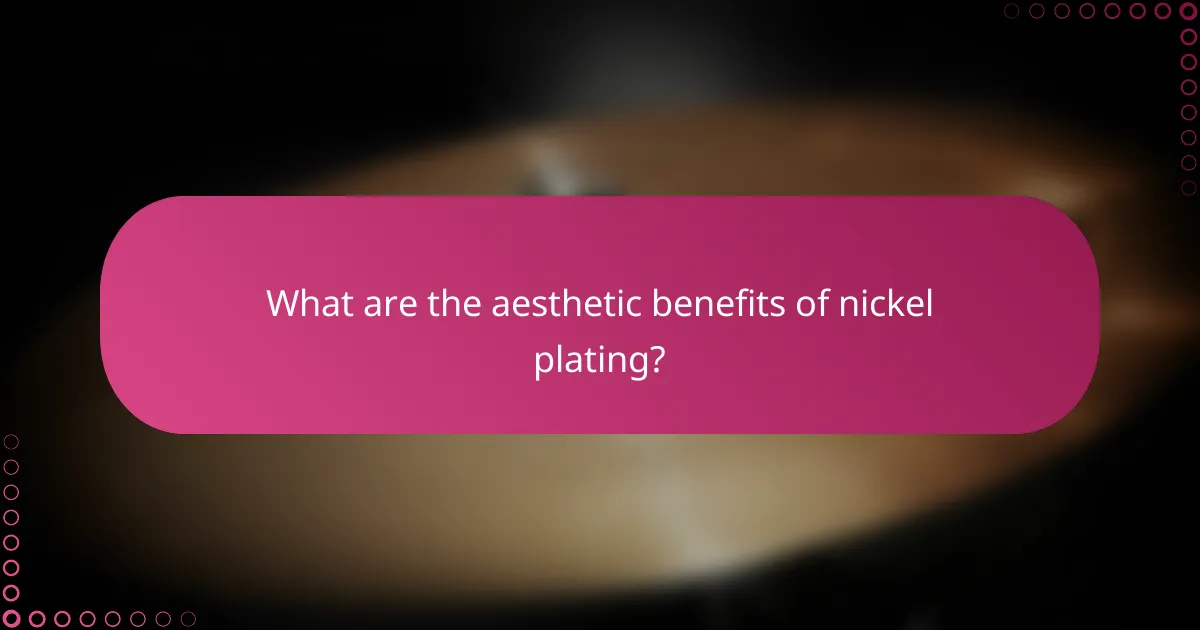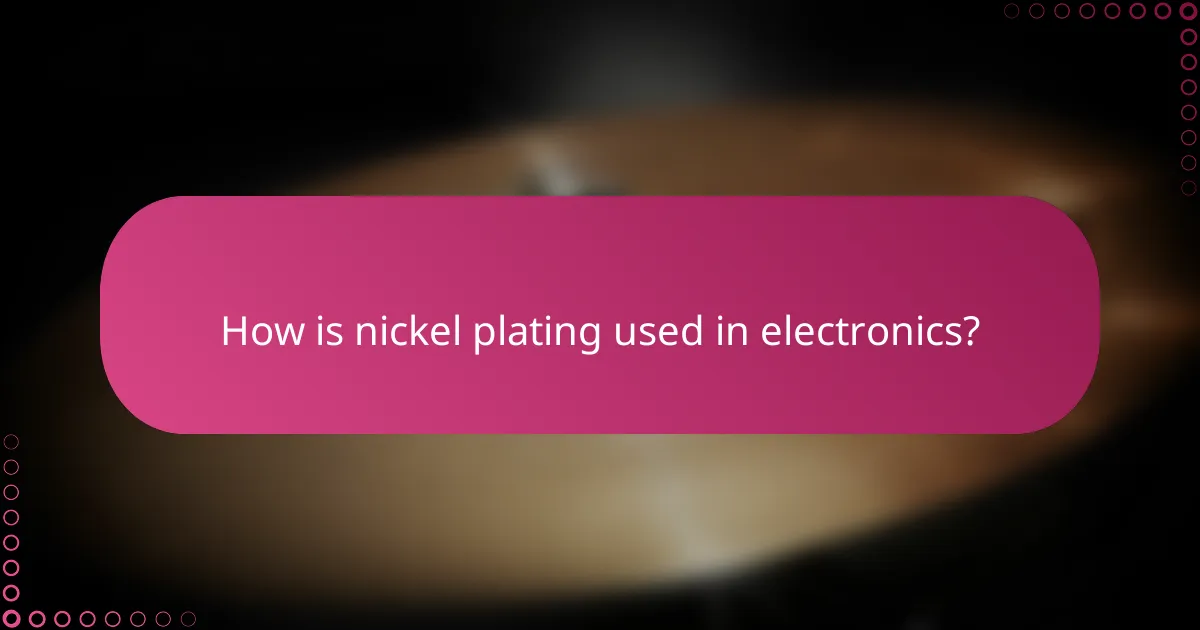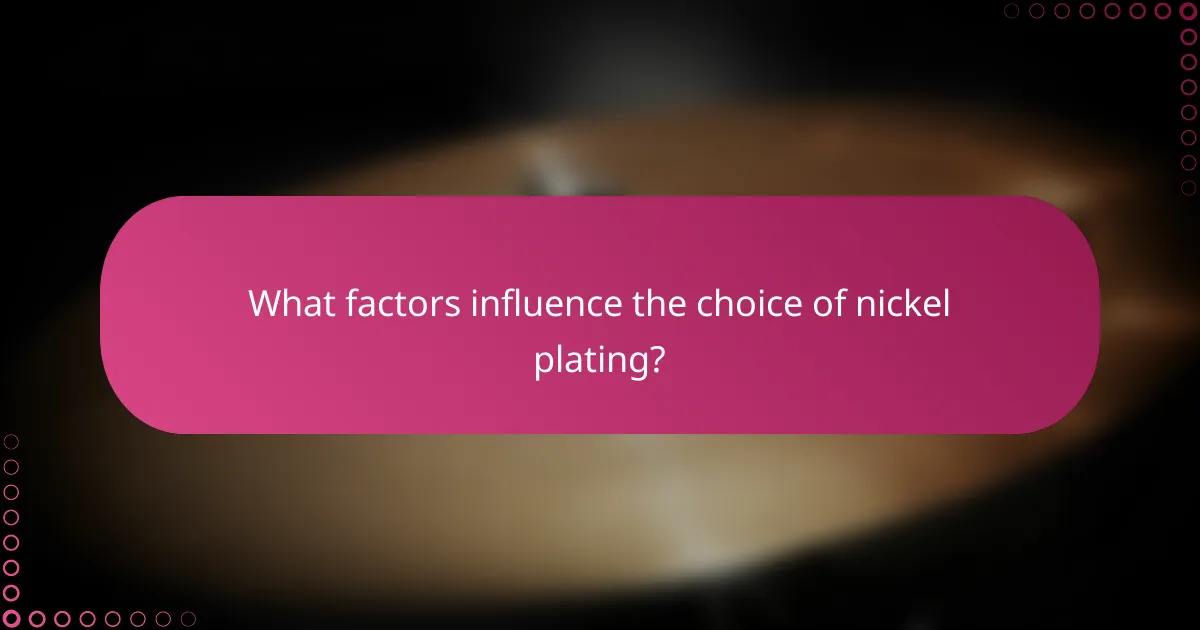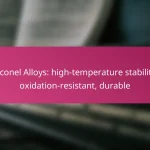Nickel plating is a versatile process that provides effective corrosion protection by forming a durable barrier on metal surfaces, thereby extending their lifespan. In addition to its protective qualities, nickel plating enhances the aesthetic appeal of products, making them more visually appealing and marketable. This technique is particularly valuable in the electronics industry, where it improves component performance and durability by enhancing conductivity and reducing wear.

How does nickel plating protect against corrosion?
Nickel plating protects against corrosion by creating a thin, durable layer on metal surfaces that acts as a barrier against environmental factors. This process not only enhances the aesthetic appeal of the metal but also significantly extends its lifespan by preventing rust and oxidation.
Forms a protective barrier
Nickel plating forms a protective barrier that isolates the underlying metal from moisture, air, and other corrosive elements. This barrier is crucial in preventing direct contact with corrosive agents, which can lead to deterioration over time.
The thickness of the nickel layer can vary, typically ranging from a few micrometers to several hundred micrometers, depending on the application and required protection level. A thicker layer generally provides better corrosion resistance.
Enhances durability of metals
Nickel plating enhances the durability of metals by improving their resistance to wear and tear. This is particularly beneficial in applications where metals are subjected to friction or mechanical stress.
For example, components in automotive and aerospace industries often utilize nickel plating to ensure they withstand harsh operating conditions while maintaining structural integrity.
Resists oxidation and rust
Nickel plating effectively resists oxidation and rust, which are common issues for unprotected metals. The nickel layer prevents oxygen from reacting with the underlying metal, thereby reducing the likelihood of rust formation.
This characteristic is especially important in humid or wet environments, where unprotected metals would quickly corrode. Nickel-plated items can maintain their appearance and functionality for years with minimal maintenance.
Suitable for marine environments
Nickel plating is particularly suitable for marine environments due to its excellent resistance to saltwater corrosion. This makes it a preferred choice for components used in boats, ships, and offshore structures.
When selecting nickel plating for marine applications, it is essential to consider the specific conditions, such as salinity and temperature, to ensure optimal performance and longevity of the plated components.

What are the aesthetic benefits of nickel plating?
Nickel plating offers significant aesthetic benefits, enhancing the appearance of products while providing a protective layer. This process results in a visually appealing finish that can elevate the overall design and marketability of various items.
Provides a shiny finish
Nickel plating creates a bright, reflective surface that is highly desirable in many applications. The shiny finish not only improves the look of products but also helps to mask minor surface imperfections, making items appear more polished and professional.
This reflective quality is particularly beneficial for consumer goods, automotive parts, and decorative items, where first impressions matter. A shiny finish can significantly enhance the perceived value of a product.
Enhances visual appeal of products
The aesthetic enhancement from nickel plating can make products more attractive to consumers, influencing purchasing decisions. The sleek and modern look of nickel-plated items can be a strong selling point in competitive markets.
For example, kitchen appliances, jewelry, and hardware often utilize nickel plating to achieve a sophisticated appearance. This visual appeal can lead to higher customer satisfaction and brand loyalty.
Available in various finishes
Nickel plating is versatile and can be applied in different finishes, including bright, satin, and matte. Each finish offers unique aesthetic qualities, allowing manufacturers to choose the best option for their specific design goals.
Bright nickel plating provides a high-gloss look, while satin finishes offer a softer, more understated appearance. Matte finishes can give a contemporary feel, appealing to modern design sensibilities. This variety enables customization to meet diverse consumer preferences.

How is nickel plating used in electronics?
Nickel plating is commonly used in electronics to enhance the performance and durability of components. It provides a protective layer that improves conductivity and reduces wear, making it ideal for various electronic applications.
Improves conductivity
Nickel plating enhances the conductivity of electronic components by providing a smooth and conductive surface. This is particularly important in applications where efficient electrical flow is critical, such as in connectors and circuit boards.
The conductive properties of nickel allow for better signal transmission, which can improve the overall performance of electronic devices. This is especially beneficial in high-frequency applications where signal integrity is paramount.
Reduces electrical resistance
Nickel plating helps to reduce electrical resistance in electronic components, which can lead to improved efficiency and lower energy consumption. Lower resistance means that less energy is lost as heat, which is crucial for maintaining optimal performance in electronic systems.
By minimizing resistance, nickel plating can also extend the lifespan of components by reducing the risk of overheating and related failures. This is particularly relevant in power electronics and high-current applications.
Used for connectors and circuit boards
Nickel plating is widely used for connectors and circuit boards due to its excellent corrosion resistance and durability. Connectors often face harsh environments, and nickel plating protects them from oxidation and wear, ensuring reliable connections over time.
In circuit boards, nickel plating is applied to pads and vias to enhance solderability and improve electrical connections. This process is essential for ensuring that components remain securely attached and function correctly in various electronic devices.

What factors influence the choice of nickel plating?
The choice of nickel plating is influenced by several key factors including the type of substrate material, the desired finish quality, and the environmental conditions the plated item will face. Each of these elements plays a crucial role in determining the effectiveness and suitability of the nickel plating process for specific applications.
Type of substrate material
The substrate material significantly affects the nickel plating process and its outcomes. Common substrates include metals like steel, aluminum, and copper, each requiring different surface preparation and plating techniques. For instance, aluminum often needs a special pre-treatment to ensure proper adhesion of the nickel layer.
When selecting nickel plating for a specific substrate, consider factors such as the substrate’s corrosion resistance, strength, and thermal properties. These characteristics will dictate the thickness and type of nickel plating required for optimal performance.
Desired finish quality
The finish quality desired from nickel plating can vary based on the application. A bright, polished finish is often preferred for decorative purposes, while a matte finish may be more suitable for industrial applications where glare reduction is important. The finish quality can also influence the thickness of the nickel layer, with thicker coatings generally providing better durability.
It’s essential to define the finish requirements early in the process, as this will guide the selection of plating methods and post-treatment processes, such as polishing or buffing, to achieve the desired aesthetic and functional properties.
Environmental conditions
Environmental conditions play a critical role in the longevity and performance of nickel plating. Factors such as humidity, exposure to chemicals, and temperature fluctuations can significantly affect the corrosion resistance of the plated surface. For example, items exposed to harsh chemicals may require a thicker nickel layer or additional protective coatings.
When assessing environmental conditions, consider the specific application and its exposure risks. Conducting a thorough analysis of the operating environment can help in selecting the appropriate nickel plating process and ensuring long-term durability of the finish.

What are the costs associated with nickel plating?
The costs associated with nickel plating can vary significantly based on factors such as thickness, regional pricing, and order volume. Generally, you can expect to pay anywhere from a few dollars to several hundred dollars per item depending on these variables.
Pricing based on thickness
The thickness of the nickel plating directly impacts the cost. Thicker coatings typically require more material and longer processing times, leading to higher prices. For instance, a standard thickness of 5 to 10 microns may cost less than $10 per part, while coatings exceeding 25 microns can reach prices of $50 or more.
When budgeting for nickel plating, consider the specific application and required durability. Thicker layers offer better corrosion resistance, which may justify the additional expense for critical components.
Cost variations by region
Regional differences can significantly affect nickel plating costs. In North America and Western Europe, prices tend to be higher due to labor costs and regulatory compliance. Conversely, countries in Eastern Europe or Asia may offer more competitive pricing, sometimes reducing costs by 20-30%.
It’s essential to factor in shipping and potential tariffs if sourcing from abroad, as these can offset any savings from lower plating costs.
Volume discounts available
Many nickel plating service providers offer volume discounts, which can lead to substantial savings for larger orders. Discounts may start at quantities as low as 50 units, with more significant reductions for orders in the hundreds or thousands.
When planning a project, inquire about bulk pricing options and compare quotes from multiple suppliers to ensure you receive the best deal. This approach can help optimize your budget while maintaining quality standards.

What are the limitations of nickel plating?
Nickel plating has several limitations that can affect its effectiveness and suitability for various applications. These include issues related to corrosion resistance, adhesion, and the potential for embrittlement in certain alloys.
Corrosion resistance
While nickel plating provides a degree of corrosion protection, it is not impervious to all environmental conditions. In highly acidic or alkaline environments, nickel can corrode, leading to potential failures. For optimal performance, consider the specific environmental factors the plated item will face.
Adhesion issues
Adhesion of nickel plating to the substrate can be problematic, especially if the surface preparation is inadequate. Poor surface cleaning or improper application techniques can result in weak bonds, leading to peeling or flaking. Ensuring thorough cleaning and proper application methods is crucial for strong adhesion.
Embrittlement concerns
Nickel plating can cause embrittlement in certain materials, particularly high-strength steels. This can reduce the overall mechanical properties of the substrate, making it more susceptible to cracking under stress. It is essential to evaluate the compatibility of nickel plating with the base material to avoid such issues.


